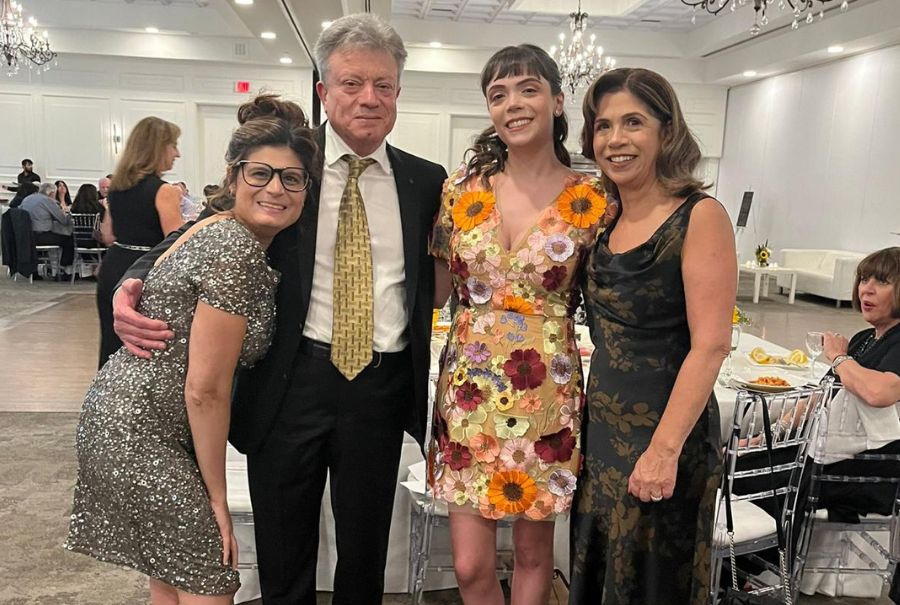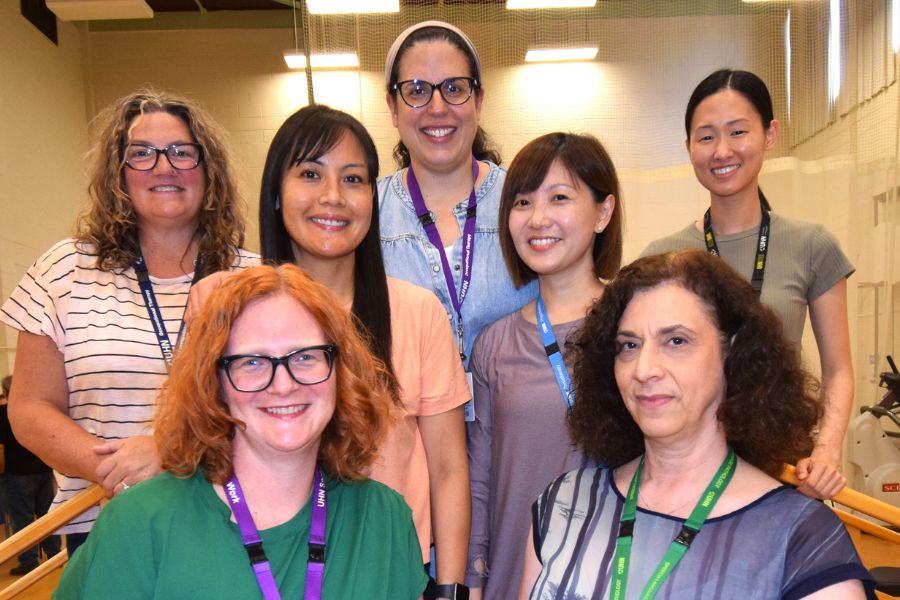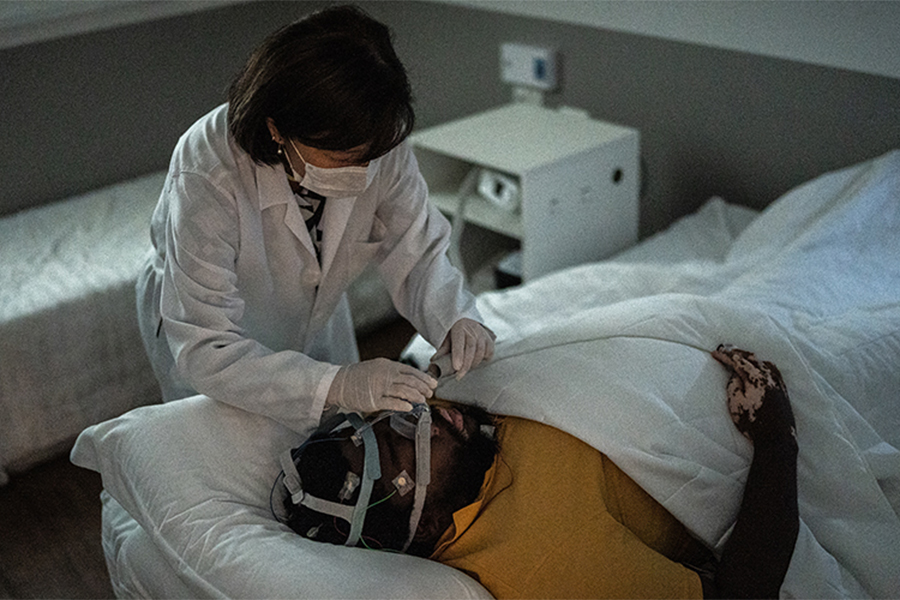For Toronto Rehab patient Frances Lamb, clinical research felt like a natural next step, and a soft place to land, post-rehabilitation. (Photo: Courtesy Frances Lamb)
Two years after a devastating trip and fall left Frances Lamb immobile from the neck down, she continues to commit herself to recovery and discovery.
And at Toronto Rehab’s Lyndhurst Centre, where innovation meets care to advance rehabilitation in patients with spinal cord injuries, she’s found support through every stage of her journey.
When Frances was admitted as an inpatient, a respirator and feeding tube had recently been removed, she was demonstrating limited mobility in her hands, shoulders and neck, and had spent the previous month laying in an acute-care bed.
Ready to face what was in front of her, Frances knew she was in the right hands, when the top priority for her care team was starting therapy to get her up, moving, and fitted for a wheelchair.
“Once we’ve conducted our own assessments to ensure patients are medically stable, it’s important to get them upright and active as soon as possible, to facilitate recovery and help the body remember what it was previously capable of doing,” says Bryan Divers, an occupational therapist.
Getting a patient up and mobile doesn’t just facilitate physical rehabilitation, he adds, but mental and cognitive recovery, as well.
Frances echoes that sentiment.
“Once I learned how to operate the chair, I was able to move around the hospital on my own, which felt great,” she recalls.
With unwavering support from her family and care team, Frances gradually worked toward discharge, realizing her goals of breathing and eating on her own, and continuing to strengthen her arms and legs.
She also learned how to make accommodations for her limited mobility.
“My occupational therapist taught me how to use an adaptive fork that wraps around my hand,” Frances says. “Being able to eat independently, without someone else’s help, was a big confidence builder.”
According to Bryan, getting properly fitted for an assistive device, and practicing using it while in the hospital, not only enhances independence in moment, but helps patients become comfortable with some of the tools they may need, to safely and successfully transition home.
Providing a seamless journey
Following a three-month stay, Frances made a smooth transition to Lyndhurst’s outpatient clinics.
“Continuing therapy at a centre I had come to know felt very comforting to me,” she says. “I remember the therapists coming right over to welcome me back, and seemed so happy to see me.”
Frances may have completed her outpatient program after 14 weeks of building strength and improving her fine motor skills, but her journey doesn’t end there.
Today, she continues to visit Lyndhurst as a research participant in the KITE Innovations and Rehab Clinics, which are clinical-research labs embedded in the hospital, that also offer public access to fee-for-service rehabilitation and technology.
So far, Frances has participated in two rehabilitation clinical trials. The first was a 15-week randomized trial comparing outcomes of conventional upper-extremity occupational therapy (OT), to functional electrical stimulation. Having been part of the conventional cohort, she was still eligible for the 16-week trial she’s currently enrolled in, studying non-invasive cervical spinal cord stimulation.
For Frances, clinical research felt like a natural next step, and a soft place to land, post-rehabilitation.
“The opportunity to potentially extend my own therapy, while helping researchers learn, is very exciting to me,” says Frances, a retired teacher.
Integrating research and care
It’s a seed that was planted during her inpatient stay, and eventually built into her discharge plans. After seeing a patient in the gym using MyndMove – a homegrown technology that uses electrical stimulation to help people with upper extremity paralysis regain movement – she asked her therapist what it was all about.
A few days later, Dr. Sukhvinder Kalsi-Ryan, a clinician-scientist and Liaison for Sustainable Research and Innovation at The KITE Research Institute, came by, performed an assessment, and explained the research and services Frances would be eligible for.
According to Dr. Kalsi-Ryan, Frances’s story demonstrates the benefits of integrating research into clinical spaces – a key priority for Toronto Rehab, moving forward.
“Through our presence, we open opportunities for patients to access innovative treatments and technologies,” she says. “And, if they do choose to work with us, the transition is seamless, because we can easily access relevant files, and have relationships with their other care providers.”
Toronto Rehab’s KITE Clinics are located at Lyndhurst and University Centre, and focus on improving outcomes for patients with neurological challenges. But it’s a model Dr. Kalsi-Ryan is passionate about growing.
“From my perspective, it’s only a matter of time before we start to offer these services at more UHN locations,” she says.
Toronto Rehab’s 2022-2025 Strategic Plan details how the organization will build on the present, to deliver the exceptional patient care of tomorrow. (Video: UHN)
Introducing the future of rehabilitation
Integrating research and care to co-invent the future of rehab, is one of four priorities detailed in Toronto Rehab’s Strategic Plan 2022-2025.
That, along with investing in the wellbeing of our team and the strength of our culture; designing seamless rehabilitation experiences, across the care continuum; and harnessing the power of technology, to revolutionize rehab, will be our shared work.
“There’s never been a more exciting – or essential – time to reimagine and redefine rehabilitation and complex continuing care,” say Janet Newton, Clinical VP, Dr. Mark Bayley, Program Medical Director and Physiatrist in Chief, and Dr. Milos Popovic, Director, The KITE Research Institute.
“The pandemic has challenged us, but has also brought to light what is possible, when we come together to achieve a common goal: to deliver exceptional patient care.”


